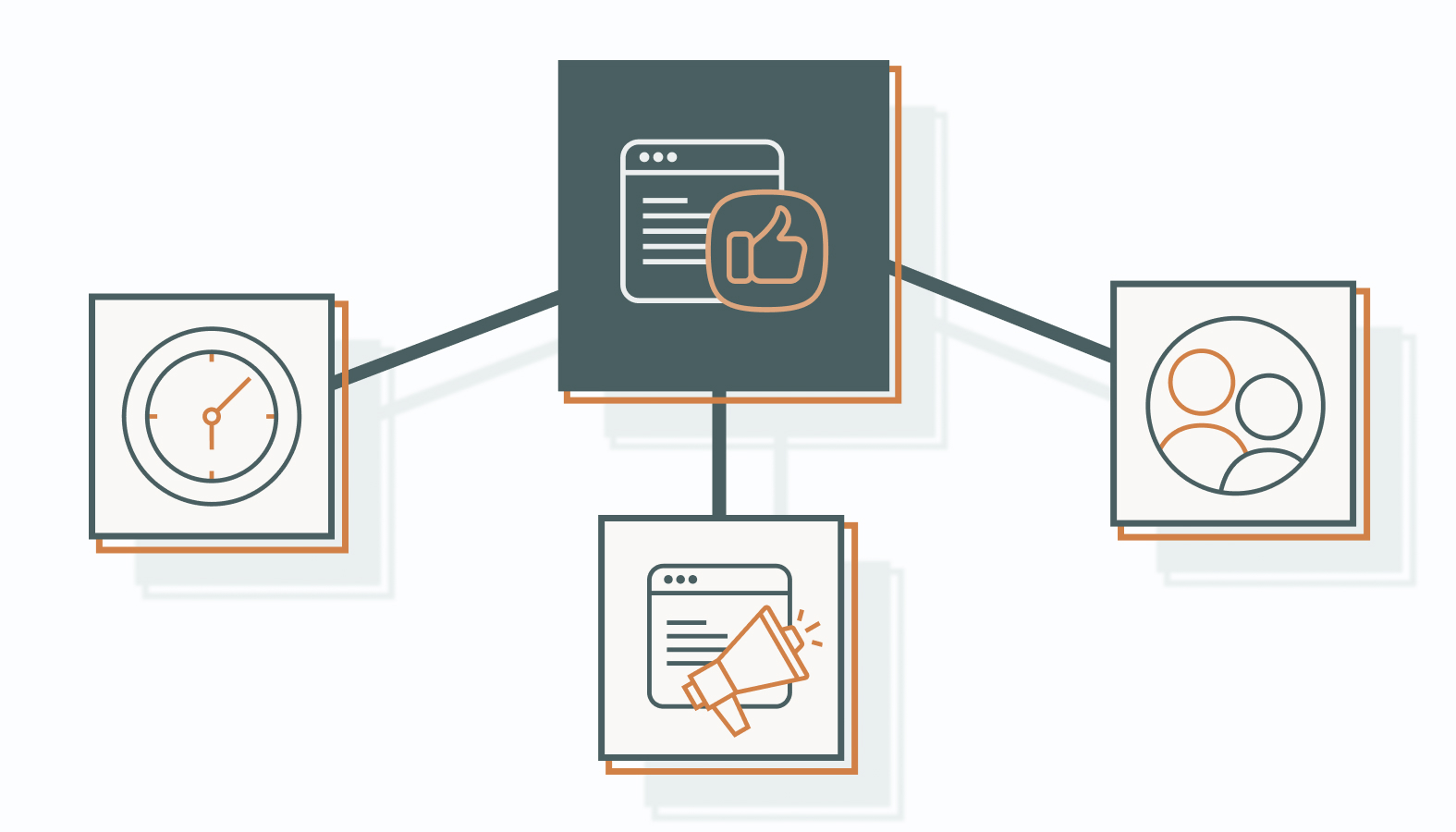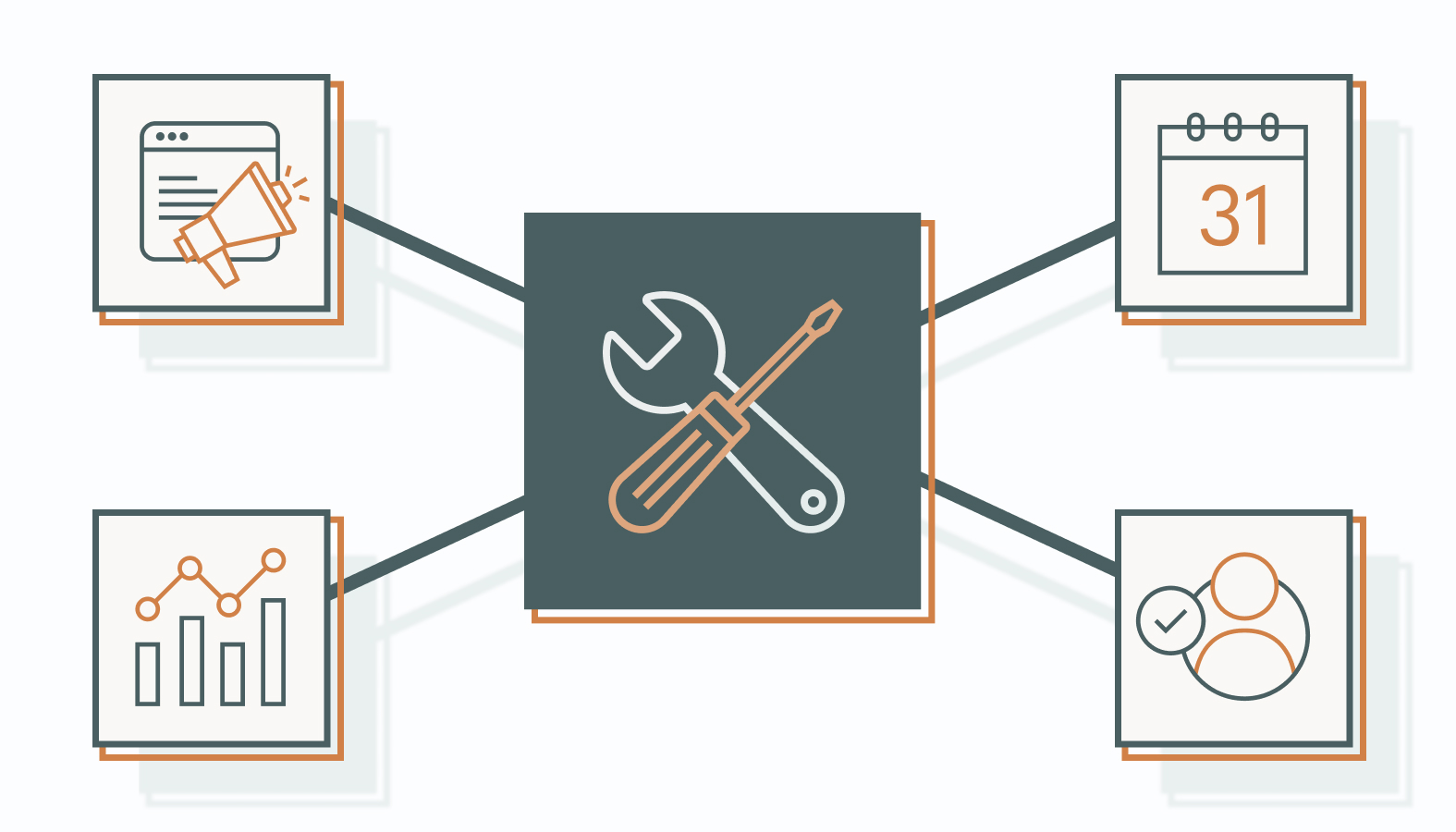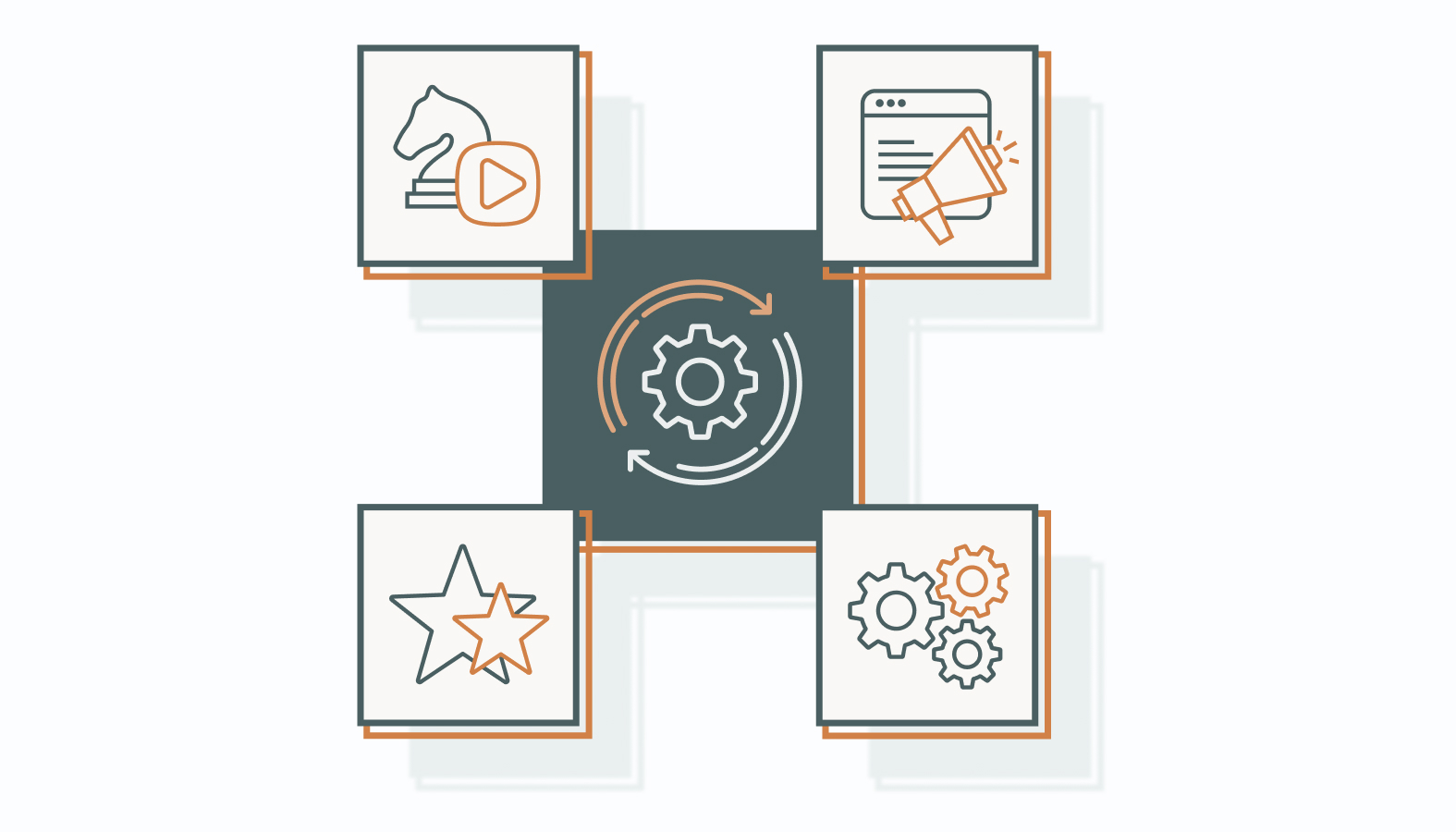You’ve got content to create, messages to reply to, data to analyze, and only so many hours in the day. That’s the exact pressure point social media marketing automation is built to solve.
In 2025 and beyond, the platforms will be smarter, the audiences will be faster, and expectations will be higher. What worked last year won’t cut it now.
If you’re still relying on manual workflows, you’re probably sacrificing reach, relevance, and ROI.
This guide will show how automation reshapes social media marketing, from scheduling and analytics to engagement and personalization. We’ll cover the smart tasks to automate, the tools that make a difference, and the common traps to avoid in today’s automated marketing landscape.
Benefits of Social Media Marketing Automation
In 2025, social media marketing automation isn’t optional; it’s infrastructure. As customer expectations evolve and platforms get more crowded, automation offers marketers the edge to stay ahead, stay consistent, and scale with precision.
Time-Saving Advantages
Automation doesn’t replace marketers. It frees them.
By handling repeatable tasks, such as scheduling posts, tagging content, managing FAQs, and compiling reports, automation gives marketers time to think bigger.
That shift from “busy work” to strategic execution can transform campaign performance and team productivity almost overnight. You’re not just saving hours; you’re compounding impact.
Enhancing Content Consistency
A disjointed posting schedule weakens brand presence. Automation platforms allow you to pre-plan campaigns, maintain a steady content cadence, and post at the exact times your audience is most active.
This builds algorithmic favor and audience trust, which are critical to visibility and long-term engagement. And when your team is in meetings, offline, or focused on other high-value work, your brand keeps showing up exactly when it should.
Improved Engagement and Audience Interaction
Responding to every comment or DM manually is a noble goal, but not sustainable.
With automation tools like intelligent chatbots and workflow triggers, you can handle high-volume interactions in real time without sacrificing quality.
Even better, the right platforms analyze engagement data to help you post smarter, optimizing content, tone, and timing based on actual user behavior.
Essential Social Media Tasks You Should Automate
The digital landscape isn’t slowing down anytime soon. If you’re still manually posting content or pulling weekly analytics by hand, you’re burning time that should be spent on strategy and innovation.
Automation is how smart marketers scale impact without scaling overhead. Here are
Optimize Content Scheduling and Publishing
Consistency fuels social media growth, but it’s tough to maintain without the right tools and strategy. Automation helps you show up regularly but it works best when it’s tied to purpose.
Here are five examples of making your scheduling more strategic:
- Use AI-driven scheduling tools to auto-publish posts when your audience is most active (e.g., Buffer’s “Best Time to Post” feature).
- Batch-create and bulk-upload content for the month to streamline your workflow and reduce day-to-day publishing pressure.
- Create a visual content calendar that aligns weekly themes with business goals, such as promoting seasonal offers or educating about product launches.
- Segment post types (e.g., testimonials on Tuesdays, tips on Thursdays) to maintain variety while reinforcing brand messaging.
- Review analytics bi-weekly to adjust publishing frequency and content mix based on what’s driving engagement and conversions.
Smart scheduling focuses on intention. The tools handle the “when,” so you focus on the “why” and “what.”
Improve Insights with Analytics and Reporting
Manual reporting eats time and stalls momentum. Automation flips that script. With tools like Google Analytics, Sprout Social, and HubSpot, you can turn raw data into instant clarity without chasing spreadsheets or wrangling exports.
To make your analytics process more efficient and insightful:
- Set up automated dashboards to track key performance metrics across platforms so you see what’s working without lifting a finger.
- Schedule recurring reports to land in your inbox weekly or monthly, highlighting top-performing content, audience growth, and ROI.
- Use UTM parameters and tracking templates to automatically attribute traffic and conversions to specific posts, campaigns, or channels.
- Leverage AI-powered insights (like predictive trends or anomaly detection) to flag unexpected spikes or drops in performance.
- Integrate reporting tools with your CRM to connect social engagement with real business outcomes such as leads, pipeline, or sales.
Automated reporting saves you time because the data works for you, so you can focus on what actually improves performance.
Enhance Interaction through Audience Engagement
Fast responses matter, and so does a human touch.
Automation tools like ManyChat, Drift, or Zendesk can handle the basics: quick replies, FAQs, lead capture, and even product recommendations. This results in faster service, 24/7 availability, and fewer dropped conversations.
To boost engagement without losing authenticity,
- Deploy intelligent chatbots to respond instantly to common DMs or comments while routing complex queries to a real person.
- Set up keyword-triggered responses to answer FAQs or guide users toward helpful resources based on what they’re asking.
- Use automated surveys or polls to collect audience feedback and spark interactive engagement with minimal effort.
- Personalize replies using CRM or social data, automatically pull in a customer’s name, location, or purchase history to make interactions feel tailored.
- Schedule time for real, human follow-ups to thank loyal followers, respond to detailed questions, or join trending conversations.
Automation should support your relationships, not replace them. Let the tools handle speed and scale, while you focus on sincerity and connection.
Must-Have Tools for Streamlining Social Media Automation
Whether you’re building a brand, scaling a campaign, or juggling multiple clients, automation tools help keep your voice consistent, your workflows lean, and your strategy informed by real data.
The right stack sharpens performance and ensures every post, comment, and insight pushes your marketing strategy forward.
Efficient Content Creation and Curation Solutions
Content creation and curation tools are indispensable for ensuring that social media posts are both high-quality and consistent. These tools help streamline the process, allowing marketers to focus more on strategy and less on execution.
Canva
Canva streamlines design for marketers who need to move fast.
With a wide range of templates, brand kits, and drag-and-drop flexibility, teams can create polished graphics in minutes (no design background required).
Canva’s collaboration features make it easy for content teams to share feedback, lock in visual standards, and keep the creative process flowing.
ChatGPT
For copywriting, ChatGPT steps in as a versatile ideation partner.
Whether you’re drafting captions, building campaign messaging, or replying to comments with nuance, this tool generates relevant, on-brand language fast.
Use it to break through writer’s block, fine-tune tone, and accelerate review cycles without sacrificing quality or voice control.
Top Scheduling Platforms for Seamless Posting
Scheduling platforms make it easy to batch, plan, and publish across multiple networks while staying responsive to peak engagement windows.
Buffer
Buffer offers an intuitive interface for scheduling posts, tracking performance, and collaborating with teams across different platforms.
Buffer’s analytics dashboard helps uncover what’s working and when to post, giving marketers a clear roadmap to optimize content strategy without constantly logging in and out of native platforms.
SocialBee
SocialBee organizes content into categories so teams can build schedules that deliver variety with intention.
Want a weekly cadence of how-to tips, user-generated content, and promotions? Done.
Plus, its platform integrations keep all your content types in sync across networks, making cohesive planning a reality.
Later
Later shines when it comes to visual content, especially for Instagram. Its drag-and-drop calendar lets you plan your grid with precision.
Beyond scheduling, Later offers audience analytics, link-in-bio tools, and content performance insights, making it a great pick for brands that lead with visuals.
Powerful Analytics and Monitoring Tools
Without measurement, you’re flying blind. The right analytics and monitoring tools turn surface-level metrics into actionable insight so you can make smarter decisions, faster.
Google Analytics
Google Analytics ties your social media campaigns to real business outcomes. By tracking traffic sources, user behavior, and conversions, you get a full picture of how social contributes to pipeline and revenue. It’s essential for identifying high-performing channels and uncovering areas that need refinement.
Sprout Social
Sprout Social goes deeper with sentiment analysis, engagement tracking, and competitive benchmarks. Its reporting tools help you prove ROI and shape strategy with precision.
For larger teams, Sprout Social’s built-in collaboration features make it easy to manage conversations, assign tasks, and ensure consistent communication across channels.
Effective Engagement and Customer Support Solutions
Audience engagement goes beyond likes; it’s about building trust and loyalty through genuine interactions. These tools help you meet customer expectations in real time without overwhelming your team with repetitive tasks.
Zendesk
Zendesk connects your customer service with your social presence. Incoming DMs, mentions, and support queries can be managed through its unified ticketing system, ensuring no message slips through the cracks. It helps teams deliver consistent, professional responses while maintaining the agility today’s audiences expect.
ManyChat
ManyChat automates the first layer of engagement through chatbot flows, helping you qualify leads, answer FAQs, and guide users toward conversion. It works across Instagram, Facebook, and WhatsApp, making it a powerful option for brands looking to scale engagement without overwhelming their human support teams.
Automation doesn’t replace the need for strategy (you still have to plan and think ahead), but it amplifies your efforts. The tools listed above form a reliable foundation for brands and marketing teams that want to increase efficiency, stay consistent, and improve results at scale.
Choose the right combination for your goals, and you’ll spend less time on manual work and more time making smart, high-impact moves.
Avoid These Pitfalls in Social Media Automation
Social media automation is a game-changer until it’s not.
It streamlines scheduling, improves consistency, and unlocks deeper insights. But lean too hard on it, and you risk sounding robotic, missing trends, or alienating your audience.
Here’s how to use automation without losing the human touch:
Avoid Over-Automation
Automation is great for routine tasks and scheduling, but overdoing it makes your brand sound robotic. Audiences crave connection, not canned responses such as:
- Scheduled posts go live during a crisis or tragedy, making your brand seem tone-deaf.
- Automated DMs feel generic or spammy, pushing followers away instead of drawing them in.
- Chatbots respond awkwardly to nuanced questions, frustrating users instead of helping them.
Use automation to handle initial interactions and repetitive work, but always layer in personalized responses and human oversight. This mix preserves your brand’s personality and builds real relationships.
Don’t Ignore Analytics
Ignoring your data blindsides your strategy. Without real-time analytics, you miss critical signals about what’s working and what’s not. For example:
- You keep pushing a campaign that’s underperforming because no one’s tracking the results.
- Content gets repeated because no one’s analyzing what’s resonating or what’s stale.
- Metrics are collected automatically but never reviewed, leaving valuable insights on the table.
Integrate automated tracking tools like Google Analytics or Sprout Social to keep your finger on the pulse. Regularly review your metrics to refine your tactics and ensure your campaigns align with your goals.
Prioritize Engagement
Automation can’t replace genuine conversations. Quick replies are fine, but deep engagement happens through meaningful interaction.
Many businesses fall trap to strategies like these:
- Followers comment with thoughtful feedback but only get canned replies or none at all.
- Brand mentions that it goes unanswered because no one is monitoring the conversation beyond alerts.
- Automated replies misinterpret tone or context, leading to miscommunication or PR slip-ups.
Use automation as a support tool, not a substitute. Encourage your team to step in personally for unique questions and community involvement. This approach strengthens loyalty and builds a community around your brand.
Master these principles, and you’ll harness automation’s power without losing the strategic insight and human touch that make your social media presence stand out.
Emerging Trends in Social Media Marketing Automation
Social media marketing has evolved from scheduled posts and basic analytics into a high-velocity engine for customer engagement powered by data and automation.
As platforms, consumer behaviors, and algorithms shift rapidly, marketers are leaning into advanced tools and AI-driven workflows to stay sharp, efficient, and relevant.
The trends below aren’t optional upgrades; they’re the new baseline for competitive digital strategy.
1) Hyper-Personalized Content Powered by AI
Personalization used to mean using someone’s first name in a subject line.
Now, AI and machine learning can analyze behavioral patterns, preferences, and timing to deliver tailored content to individuals at scale. Every click, scroll, and pause helps AI determine what resonates.
Done right, this leads to significantly higher engagement rates and better brand affinity. For example:
- Ecommerce: AI-powered product recommendations based on past purchases and real-time browsing behavior increase cart size and reduce abandonment.
- SaaS: Onboarding sequences adapt dynamically based on the user’s in-app activity, serving relevant tutorials or features based on usage patterns.
- Media & Publishing: Content platforms use AI to curate news feeds or playlists unique to each user’s reading or listening habits, boosting time on site and return visits.
Brands that lean into this level of personalization show up in feeds and feel familiar, relevant, and trustworthy to each user.
2) Real-Time Content Optimization
With real-time data analytics, marketers can adjust social media content mid-campaign based on immediate performance feedback.
Audience not responding to that carousel? Swap it out.
Trending topic hijacking your hashtags? Adjust.
For example:
- Retail: A fashion brand promotes summer dresses, but real-time weather data shows a cold front—so they pivot the campaign to highlight outerwear and layerable items in affected regions.
- Entertainment: A streaming service runs A/B tests on two trailers for an upcoming release and shifts the budget to the one generating more clicks and watchlist adds within the first 48 hours.
- Nonprofits: During a crisis response campaign, a nonprofit uses real-time engagement data to swap out underperforming donation appeals with urgent, emotionally resonant content that reflects breaking news.
Brands that operate with this kind of agility can align their messaging with shifting audience sentiment, news cycles, or platform behaviors instantly. This responsiveness keeps campaigns contextually relevant and builds stronger momentum.
3) Creating Content with AI Assistance
Creative bottlenecks slow down great campaigns.
AI tools are helping teams move faster without sacrificing originality. From drafting copy variations to generating image or video concepts, these tools accelerate ideation and eliminate repetitive production tasks.
More importantly, they free up human creatives to focus on higher-level thinking, experimentation, and campaign strategy.
For example:
- Advertising Agencies: AI generates multiple ad copy variations and visual mockups in minutes, allowing teams to A/B test creative quickly and scale high-performers.
- Retail Brands: Product photos are automatically edited and placed into lifestyle settings using AI image tools, speeding up seasonal campaign production.
- Content Marketing Teams: Long-form blog posts are outlined and partially drafted by AI based on SEO research, freeing writers to refine, add insight, and focus on strategy.
AI-assisted creative workflows result in more dynamic content that is delivered faster and with less internal drag.
4) Smarter, More Human Chatbots
Modern engagement bots aren’t the clunky scripts of years past.
With natural language processing and machine learning, they now handle inquiries, provide recommendations, and carry on conversations that feel authentically helpful.
Whether answering product questions or guiding users through service processes, these bots offer real-time, platform-native support at scale.
For example:
- Ecommerce: Chatbots help customers find the right product by asking preference-based questions and instantly offering personalized options.
- B2B SaaS: Bots qualify leads by asking strategic questions, scheduling demos, and routing high-intent visitors to sales reps, all without human intervention.
- Travel & Hospitality: Virtual agents assist with booking changes, upgrades, and personalized travel tips, creating a concierge-like experience 24/7.
When integrated well, automation ensures no interaction goes unanswered, and in turn, improves customer satisfaction and brand consistency.
5) Predictive Scheduling and Audience Timing
Knowing when to post is just as critical as knowing what to post.
Predictive analytics tools now help brands identify the optimal timing for maximum reach and engagement. These tools evaluate audience behavior trends across time zones, devices, and historical data, taking the guesswork out of scheduling.
For example:
- Retail: Social ads for flash sales are scheduled during peak buying hours for different segments, increasing conversions and minimizing ad waste.
- Fitness Apps: Push notifications for new workout plans are timed around users’ typical exercise windows, improving open rates and daily engagement.
- B2B Marketing: Email campaigns are automatically staggered by time zone and user work habits, ensuring content hits inboxes when decision-makers are most active.
Strategic timing gives content the best chance to actually connect when your audience is most receptive.
Leaning into these emerging trends will make your social media more efficient and more human. Brands that adapt faster build stronger connections, create more relevant experiences, and set themselves up for long-term wins in a constantly shifting digital game.
Automation’s Role in Shaping the Future of Social Media Marketing
Automation is no longer just a tool; it’s a cornerstone of effective social media marketing in 2025. By handling repetitive tasks, it frees marketers to focus on creativity, strategy, and meaningful connections.
As you’ve seen, automation delivers consistent content, smarter engagement, and personalized experiences that resonate.
AI-driven insights and real-time data allow brands to stay agile, adapting to trends and audience needs quickly.
Yet, the real power lies in balancing technology with authenticity, using automation to scale while keeping your brand’s unique voice alive.
The future belongs to brands that combine efficient automation with genuine human interaction. When done right, this blend drives stronger relationships, better performance, and sustainable growth in an ever-evolving digital landscape.
Take Control of Your Social Media Automation Journey
Unlock new levels of efficiency, engagement, and personalization by integrating automation into your marketing playbook — without losing the authentic connection your audience expects.
If you want to explore tailored automation solutions or have questions about evolving your social media strategy, we’re here to help. No jargon, no pressure; just clear, actionable advice that fits your business.
Schedule a candid conversation with one of our experts » and we’ll make sure your brand stands out and thrives in today’s fast-paced digital world.









